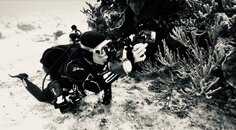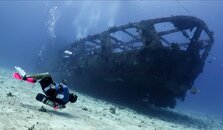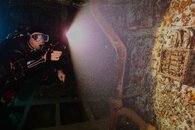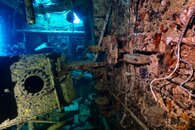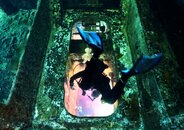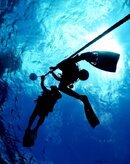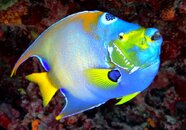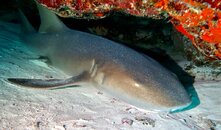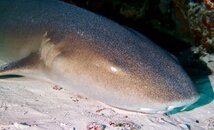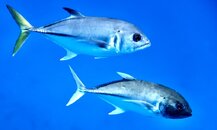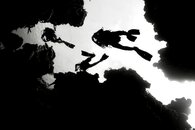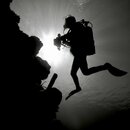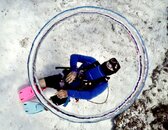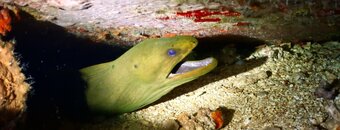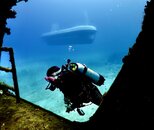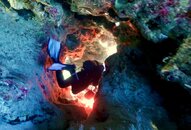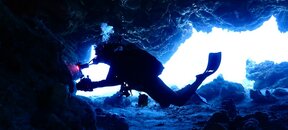David Haas
Contributor
I'll add a few insights......
If macro and ONLY macro is your underwater jam the TG6 or TG-7 is a worthy choice. The ease of small size, less $$$$ and ease of settings is great. Many users don't / won't ever get into that "ISO, F-stop / shutter speed" mumbo jumbo and believe me the cameras manufacturers have the optimum settings for those underwater scenarios and their sensor figured out better than almost all shooters clinging to "old school" shooting proclamations.
It's 2024 and no matter what previous shooters of many generations tout it's incredibly easy to get spectacular MACRO shots with those small cameras. Yes, battery life will necessitate changing more often if shooting with the flash either in the housing or tripping a small accessory flash. I've also seen fabulous MACRO shots taken with a low power (1000 - 2000 lumens) flashlight (!!!!!!)
For anything bigger than like reef fish, sponge / coral shots, wide angle animals, full frame dive buddy shots something in the 1" sensor compact choice like a Canon G7X II or III or Sony RX100 V / VA VII would be better. But it will require that pesky "ISO / F-Stop / Shutter Speed" learning to get the most out of these cameras.
The next jump is an APS-C sensor camera for more detail and speed. You're looking at a Sony A6400 / 6600 / 6700 or the lower priced but great Canon R100 / R50. The Canon R50 is preferred in my opinion being a Canon guy but housing with possibly interchangeable ports and a tray / arms, strobes will push this into a much more expensive endeavor. Not to mention increased size while travel and diving
I recently went to Cozumel for fun diving with my Canon G7X II in a Fantasea housing. No strobe, only my pop on "Air Lens" restoring my camera's native 24mm focal length underwater. I could pop off the Air Lens and shoot closer but I'm just not interested in MACRO these days.
I used my camera's white balance to restore ambient colors and a few shots with the built in flash and my housing's pop on diffuser. After a day or so I just used a 1000 lumen flashlight for some shots and was more than happy with my photos.
My amigo' had his Canon R50 in a low priced SeaFrogs housing. While the housing kept his cameras dry the built in flash wouldn't fire below 15 feet
We tried and tried to keep it popped up tripping his dual Inon S2000 strobes but nada', zip, nothing worked......
We emailed SeaFrogs in Hong Kong alerting them the FLASH LIGHTNING BOLT icon would be on the camera's LCD on the surface and fire down to 15' where it then would simply disappear
They finally admitted it was something (housing flexing or ?????) that prevented it from working.
He pivoted to using a 5000 lumen light he just bought (it claimed 8000 lumens on Amazon for only like $89.00!) and got some great shots.
Supposedly SeaFrogs is working on a hot shoe enabled LED trigger but I'll bet will only be a manual "blip" trigger.
This means whatever strobe(s) you own with S-TTL automatic flash control you'll be back to "guessing the proper flash output setting" meaning more missed exposures
MANUAL flash control is fine for things that sit still but for fish, divers or whatever is 1.5' away then the next 3' away manual flash setting simply sucks........
The long end to this story is if you go for an APS-C interchangeable lens camera be SURE your housing choice allows MANUAL and AUTOMATIC LED triggering capability from the camera's built in flash. Meaning the housing has little window ports for your camera's flash.
This is the most reliable taking problems "out of the chain" of camera flash to external fiber optic cords and any accessory flash.
My friend Nemrod has posted many times of frustration with big $$$$ hot shoe LED flash trigger reliability. I am amazed people put up with those things especially for the cost!
Right now for the Canon R50 and Sony A6000 models you'll need a Nauticam housing.
Not cheap but well made and they simply work but at increased $$$$ cost.....
Another friend has the Nauticam Canon R50 housing and it is tiny.........Works great with full flash capability and the only downside if you want super wide angle you're looking at a $1200 - $1500 Nauticam WWL-B or WWL-C bayonet lens to maximize the Canon R50's 18-45mm "kit" lens in the housing. But it sure produces great pics and even shoots fabulous full sensor 4K video....
For me, I'm staying with my 1" sensor Canon Canon G7X II. With AI sharpening, up-rezzing files and noise reduction software I can tweak shots easily for my needs, including making big prints.
Shoot whatever you like and budget allows! Just keep on enjoying the underwater world!
David Haas - AKA "Old Diving Photographer"

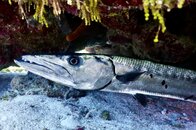
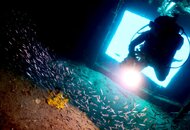
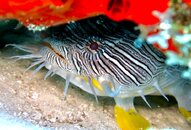

If macro and ONLY macro is your underwater jam the TG6 or TG-7 is a worthy choice. The ease of small size, less $$$$ and ease of settings is great. Many users don't / won't ever get into that "ISO, F-stop / shutter speed" mumbo jumbo and believe me the cameras manufacturers have the optimum settings for those underwater scenarios and their sensor figured out better than almost all shooters clinging to "old school" shooting proclamations.
It's 2024 and no matter what previous shooters of many generations tout it's incredibly easy to get spectacular MACRO shots with those small cameras. Yes, battery life will necessitate changing more often if shooting with the flash either in the housing or tripping a small accessory flash. I've also seen fabulous MACRO shots taken with a low power (1000 - 2000 lumens) flashlight (!!!!!!)
For anything bigger than like reef fish, sponge / coral shots, wide angle animals, full frame dive buddy shots something in the 1" sensor compact choice like a Canon G7X II or III or Sony RX100 V / VA VII would be better. But it will require that pesky "ISO / F-Stop / Shutter Speed" learning to get the most out of these cameras.
The next jump is an APS-C sensor camera for more detail and speed. You're looking at a Sony A6400 / 6600 / 6700 or the lower priced but great Canon R100 / R50. The Canon R50 is preferred in my opinion being a Canon guy but housing with possibly interchangeable ports and a tray / arms, strobes will push this into a much more expensive endeavor. Not to mention increased size while travel and diving
I recently went to Cozumel for fun diving with my Canon G7X II in a Fantasea housing. No strobe, only my pop on "Air Lens" restoring my camera's native 24mm focal length underwater. I could pop off the Air Lens and shoot closer but I'm just not interested in MACRO these days.
I used my camera's white balance to restore ambient colors and a few shots with the built in flash and my housing's pop on diffuser. After a day or so I just used a 1000 lumen flashlight for some shots and was more than happy with my photos.
My amigo' had his Canon R50 in a low priced SeaFrogs housing. While the housing kept his cameras dry the built in flash wouldn't fire below 15 feet
We tried and tried to keep it popped up tripping his dual Inon S2000 strobes but nada', zip, nothing worked......
We emailed SeaFrogs in Hong Kong alerting them the FLASH LIGHTNING BOLT icon would be on the camera's LCD on the surface and fire down to 15' where it then would simply disappear
They finally admitted it was something (housing flexing or ?????) that prevented it from working.
He pivoted to using a 5000 lumen light he just bought (it claimed 8000 lumens on Amazon for only like $89.00!) and got some great shots.
Supposedly SeaFrogs is working on a hot shoe enabled LED trigger but I'll bet will only be a manual "blip" trigger.
This means whatever strobe(s) you own with S-TTL automatic flash control you'll be back to "guessing the proper flash output setting" meaning more missed exposures
MANUAL flash control is fine for things that sit still but for fish, divers or whatever is 1.5' away then the next 3' away manual flash setting simply sucks........
The long end to this story is if you go for an APS-C interchangeable lens camera be SURE your housing choice allows MANUAL and AUTOMATIC LED triggering capability from the camera's built in flash. Meaning the housing has little window ports for your camera's flash.
This is the most reliable taking problems "out of the chain" of camera flash to external fiber optic cords and any accessory flash.
My friend Nemrod has posted many times of frustration with big $$$$ hot shoe LED flash trigger reliability. I am amazed people put up with those things especially for the cost!
Right now for the Canon R50 and Sony A6000 models you'll need a Nauticam housing.
Not cheap but well made and they simply work but at increased $$$$ cost.....
Another friend has the Nauticam Canon R50 housing and it is tiny.........Works great with full flash capability and the only downside if you want super wide angle you're looking at a $1200 - $1500 Nauticam WWL-B or WWL-C bayonet lens to maximize the Canon R50's 18-45mm "kit" lens in the housing. But it sure produces great pics and even shoots fabulous full sensor 4K video....
For me, I'm staying with my 1" sensor Canon Canon G7X II. With AI sharpening, up-rezzing files and noise reduction software I can tweak shots easily for my needs, including making big prints.
Shoot whatever you like and budget allows! Just keep on enjoying the underwater world!
David Haas - AKA "Old Diving Photographer"








